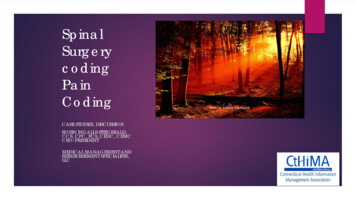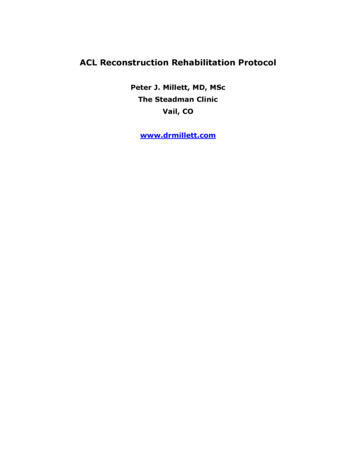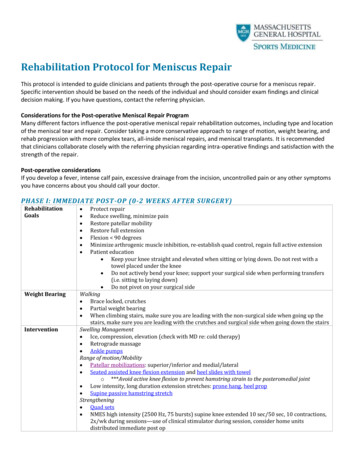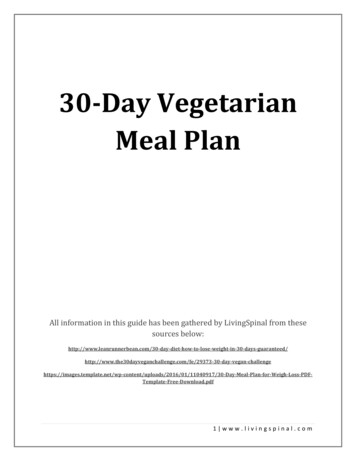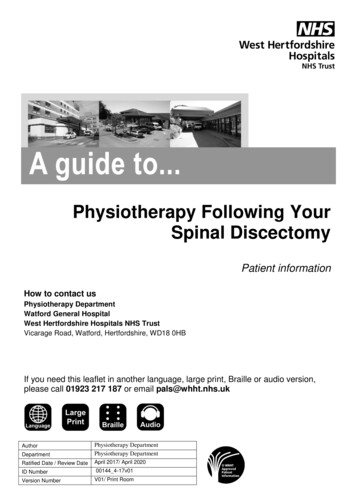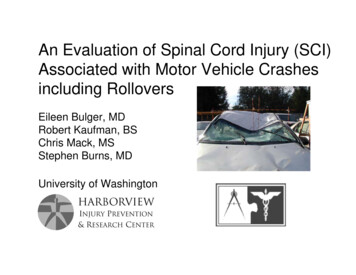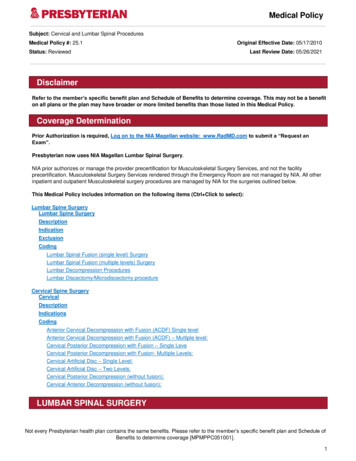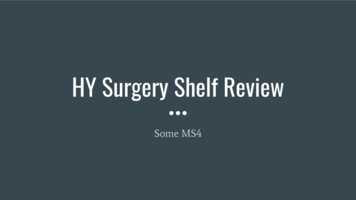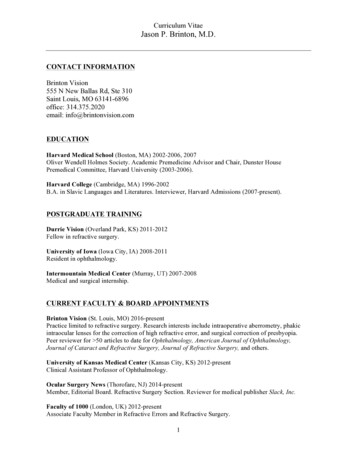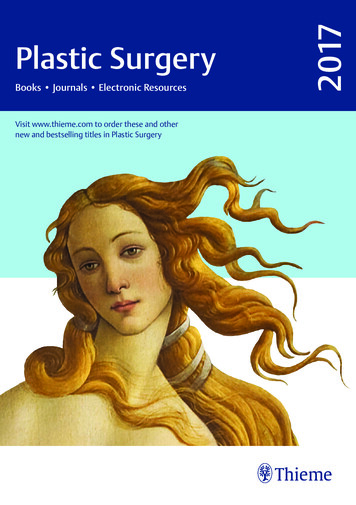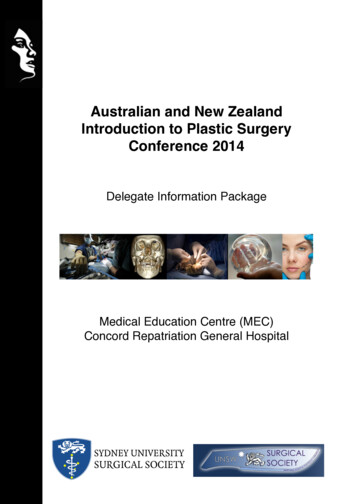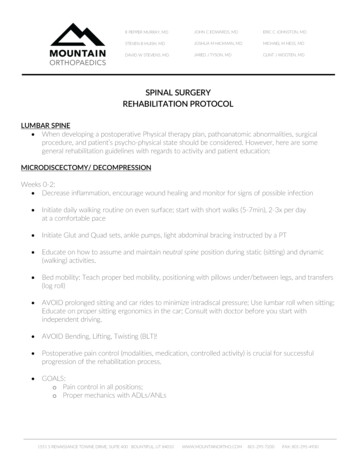
Transcription
R PEPPER MURRAY, MDJOHN C EDWARDS, MDERIC C JOHNSTON, MDSTEVEN B HUISH, MDJOSHUA M HICKMAN, MDMICHAEL M HESS, MDDAVID W STEVENS, MDJARED J TYSON, MDCLINT J WOOTEN, MDSPINAL SURGERYREHABILITATION PROTOCOLLUMBAR SPINE When developing a postoperative Physical therapy plan, pathoanatomic abnormalities, surgicalprocedure, and patient’s psycho-physical state should be considered. However, here are somegeneral rehabilitation guidelines with regards to activity and patient education:MICRODISCECTOMY/ DECOMPRESSIONWeeks 0-2: Decrease inflammation, encourage wound healing and monitor for signs of possible infection Initiate daily walking routine on even surface; start with short walks (5-7min), 2-3x per dayat a comfortable pace Initiate Glut and Quad sets, ankle pumps, light abdominal bracing instructed by a PT Educate on how to assume and maintain neutral spine position during static (sitting) and dynamic(walking) activities. Bed mobility: Teach proper bed mobility, positioning with pillows under/between legs, and transfers(log roll) AVOID prolonged sitting and car rides to minimize intradiscal pressure; Use lumbar roll when sitting;Educate on proper sitting ergonomics in the car; Consult with doctor before you start withindependent driving. AVOID Bending, Lifting, Twisting (BLT)! Postoperative pain control (modalities, medication, controlled activity) is crucial for successfulprogression of the rehabilitation process. GOALS:o Pain control in all positions;o Proper mechanics with ADLs/ANLs1551 S RENAISSANCE TOWNE DRIVE, SUITE 400 BOUNTIFUL, UT 84010WWW.MOUNTAINORTHO.COM801-295-7200FAX: 801-295-4930
Weeks 2-6: Body Mechanics training and Postural Exercises; It should include training about appropriate bodymechanics for bending, lifting, bed transfers, body hygiene (i.e. brushing teeth) Limit lifting 10-15 lbs with proper lifting mechanics Passive stretching (HS, Quads, hip/pelvic musculature) Neural Mobilization (sciatic and femoral nerve), including as part of HEP Pelvic and Core neuromuscular re-education and stabilization progression (static dynamic) Progress low impact aerobic conditioning (walking, recumbent bike) up to 30 min/day Low impact functional activity is encouraged and should be progressed as tolerated. Initiate Aquatics if available and indicated GOALS:o Walking up to 1 mile/dayo Pain controlWeek 6 : Advanced core and pelvic girdle stabilization (multi-plane stabilization) Activity specific training and conditioning; Work hardening activity (i.e. lifting and bendingmechanics, squatting) Coordination and proprioceptive re-training to improve static and dynamic balance of the core andextremities Advanced aerobic conditioning (Elliptical Machine) Gradually resume with all ADLs/ANLs, guided by pain FCE / Return to work program if indicated GOALS:o Walking up to 2 miles/dayo Able to lift up to 20lbs with proper mechanicso Pain-free ADLs/ANLsLUMBAR FUSION0-3 Months: Decrease inflammation, encourage wound healing and monitor for signs of possible infection Bed mobility: teach proper bed mobility, positioning side-lying and supine with pillows, and bedtransfers (log roll)1551 S RENAISSANCE TOWNE DRIVE, SUITE 400 BOUNTIFUL, UT 84010WWW.MOUNTAINORTHO.COM801-295-7200FAX: 801-295-4930
Initiate deep breathing exercises and ankle pumps/glut/quad sets to help with circulation Sit at 30-minute intervals throughout the day, including meals; Avoid prolonged sitting/car rides Ambulation progression as tolerated; initially with assistive device if needed to normalize gait andpostural mechanics AVOID Bending/ Lifting/ Twisting (BLT)! GOALS:o Pain controlo Short walks/cycling but avoiding as much lumbar and lumbopelvic motion as possible, 5-10minutes 2-3 times per day In the first 3 months, we’re purposefully avoiding any type of core stabilization (including isometrics)in order to prevent any excessive pulling on the fusion site and therefore promote proper healingfrom bone to bone. (good bone healing takes about 12 weeks)3 months : After a follow up with the surgeon, formal PT may be initiated. Gradually progress core and pelvic girdle stabilization Focus on pelvic, hip, and lower quadrant flexibility (HS, piriformis, gluteals, hip flexors) Thoracic spine mobilization (manual joint mobilization and passive stretching) Progress low impact aerobic conditioning (walking, recumbent bike) Consider aquatic therapy with intent to become an independent maintenance program GOALS:o Walking up to 2 mi/dayo Bending, Lifting, Twisting as tolerated without pain.o Goal is to slowly and gently return to full pre-surgical activity by 6 months.CERVICAL SPINEAnterior Cervical Discectomy/Decompression and Fusion (ACDF)Consider the following guidelines after anterior cervical spine fusion:0-6 weeks: Decrease inflammation, encourage wound healing and monitor for signs of possible infection Low impact aerobics reconditioning (walking, stationary bike) Initiate neural gliding (median, ulnar, radial nerve)1551 S RENAISSANCE TOWNE DRIVE, SUITE 400 BOUNTIFUL, UT 84010WWW.MOUNTAINORTHO.COM801-295-7200FAX: 801-295-4930
Shoulder shrug, rowing type exercises are encouraged to help with feeling of tightness in posteriorcervical area. No need to restrict lifting and carrying much. Avoid any significant cervical ROM and stretching until 6 weeks or when cleared by MD (ADLs aregenerally ok) GOALS:o Return to most daily activities and non-hard-hat work and avoid excessive guarding.Most patients can return to an office job right away and can resume most ADLs withoutrestriction when comfortable.6 weeks : Gentle active cervical ROM, avoiding end range stretch (less than 50% of pre-operative range Address potential hypomobility in T/S and Cervico-thoracic junction Soft tissue mobilization, stretching, and taping as indicated to help with muscle spasm and guarding Isometric neuromuscular re-education for deep neck flexors (start in gravity-eliminated position);Progress periscapular, thoracic, and core stabilization exercises Low impact aerobics reconditioning (walking, stationary bike) Educate on proper lifting mechanics, ergonomics/work station set up No contact sports until 12 weeks. Advance to regular activities from 6-12 weeks.POSTERIOR CERVICAL FUSION WITH OR WITHOUT DECOMPRESSION Often much of the posterior musculature at the cervicothoracic junction is taken down and repairedin surgery, so it is paramount to avoid activation of the periscapular muscles for 8-12 weeks.Otherwise spreading of these muscles is worsened and a very unsightly appearance of the posteriorneck occurs (spinous processes stick out significantly) Posterior cervical procedures are much more painful than anterior procedures. Generally, patientswill be much slower to recover and return to activity.0-8 weeks: Decrease inflammation, encourage wound healing and monitor for signs of possible infection Low impact aerobics reconditioning (walking, stationary bike) Initiate neural gliding (median, ulnar, radial nerves). Care with push/pull as above.1551 S RENAISSANCE TOWNE DRIVE, SUITE 400 BOUNTIFUL, UT 84010WWW.MOUNTAINORTHO.COM801-295-7200FAX: 801-295-4930
8-10 weeks: May begin gentle shoulder shrug exercises and pushing exercises. May begin gentle flexion, extension exercises of neck. Avoid rowing/pulling exercises. Continue low impact cardio exercises.10-12 weeks: Slowly add rowing/pulling exercises to regimen. May advance neck range of motion exercises keeping in mind that if this is a fusion, the loss ofrange is permanent and pushing past the endpoint will cause pain but not produce more motion(fusion permanent sacrifice of motion) Advance low impact cardiovascular program as able.*Developed by: David W Stevens, MDTina Buchheister, PT, MPT, PerformanceWest Physical TherapyUpdated 2/20161551 S RENAISSANCE TOWNE DRIVE, SUITE 400 BOUNTIFUL, UT 84010WWW.MOUNTAINORTHO.COM801-295-7200FAX: 801-295-4930
REHABILITATION PROTOCOL LUMBAR SPINE When developing a postoperative Physical therapy plan, pathoanatomic abnormalities, surgical procedure, and patient’s psycho-physical state should be considered. However, here are some general rehabilitation guidelines with regards to activity and patient education: MICRODISCECTOMY/ DECOMPRESSION
